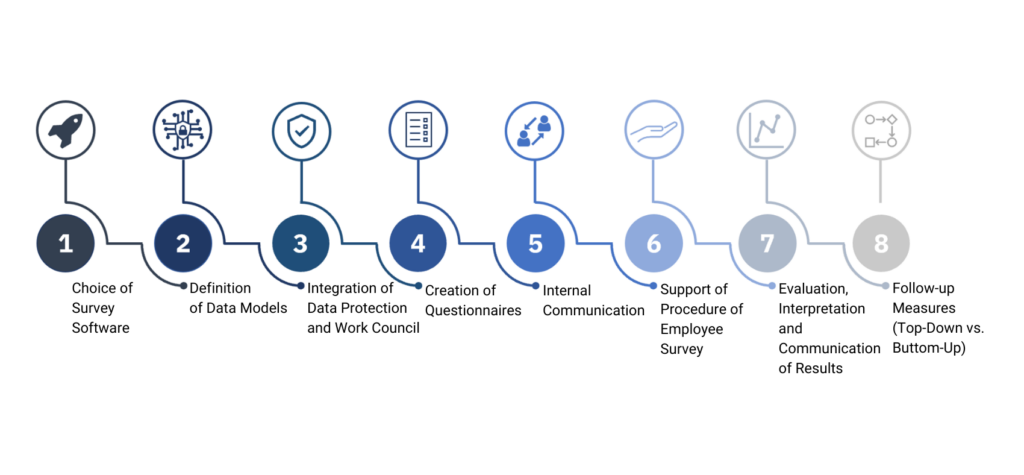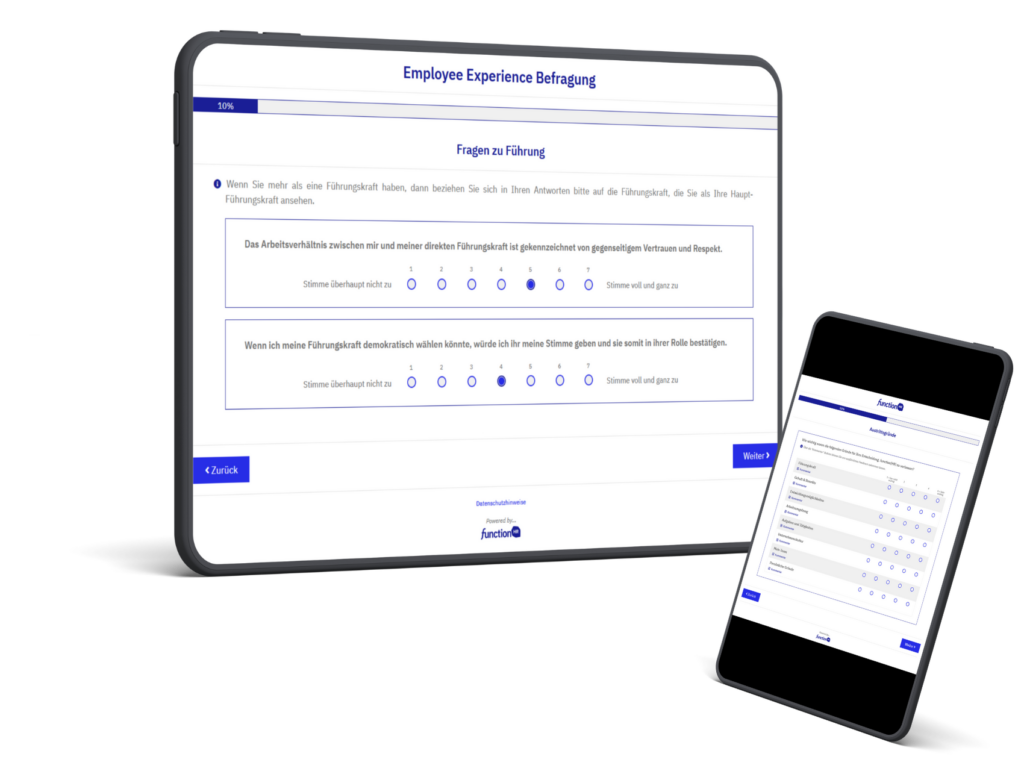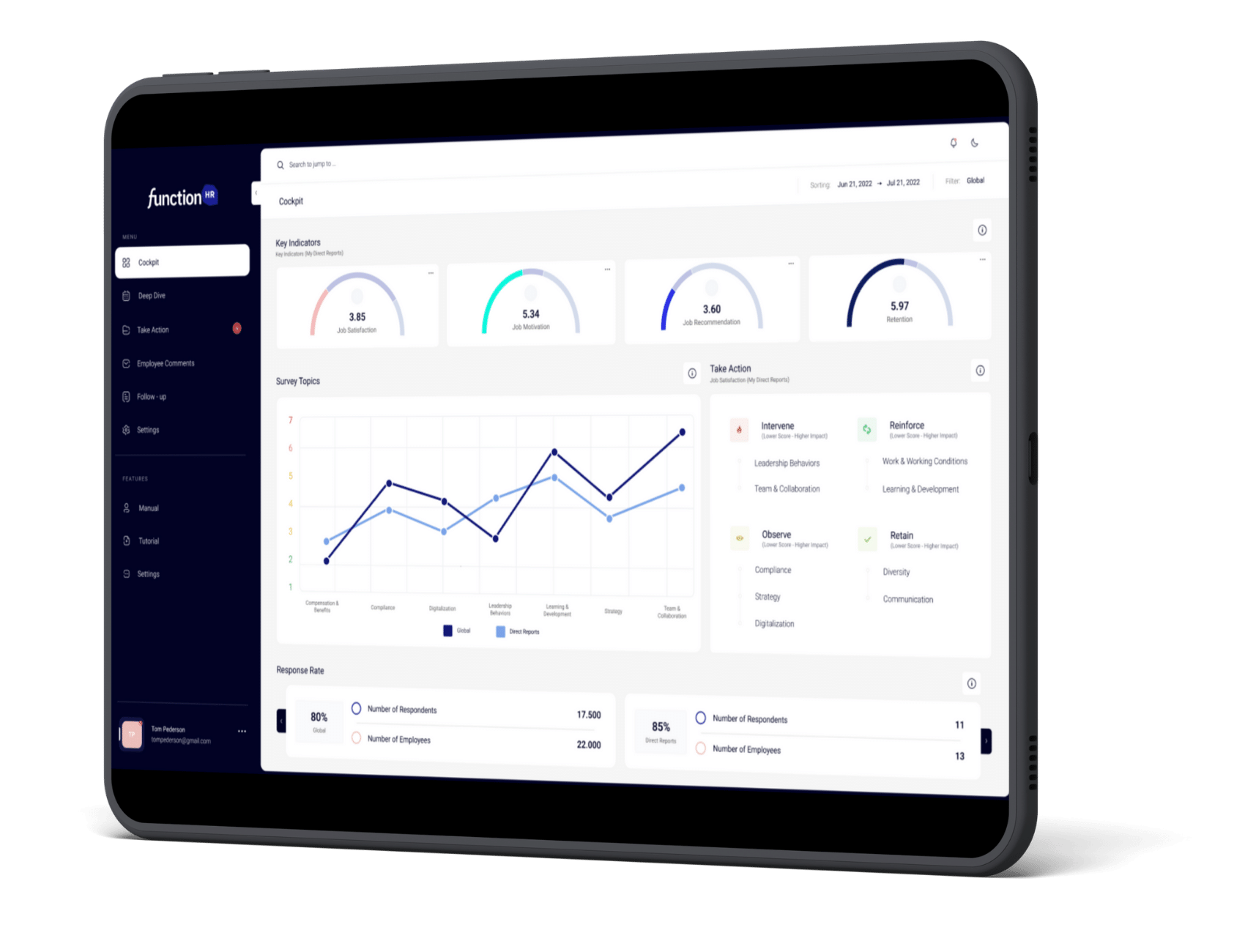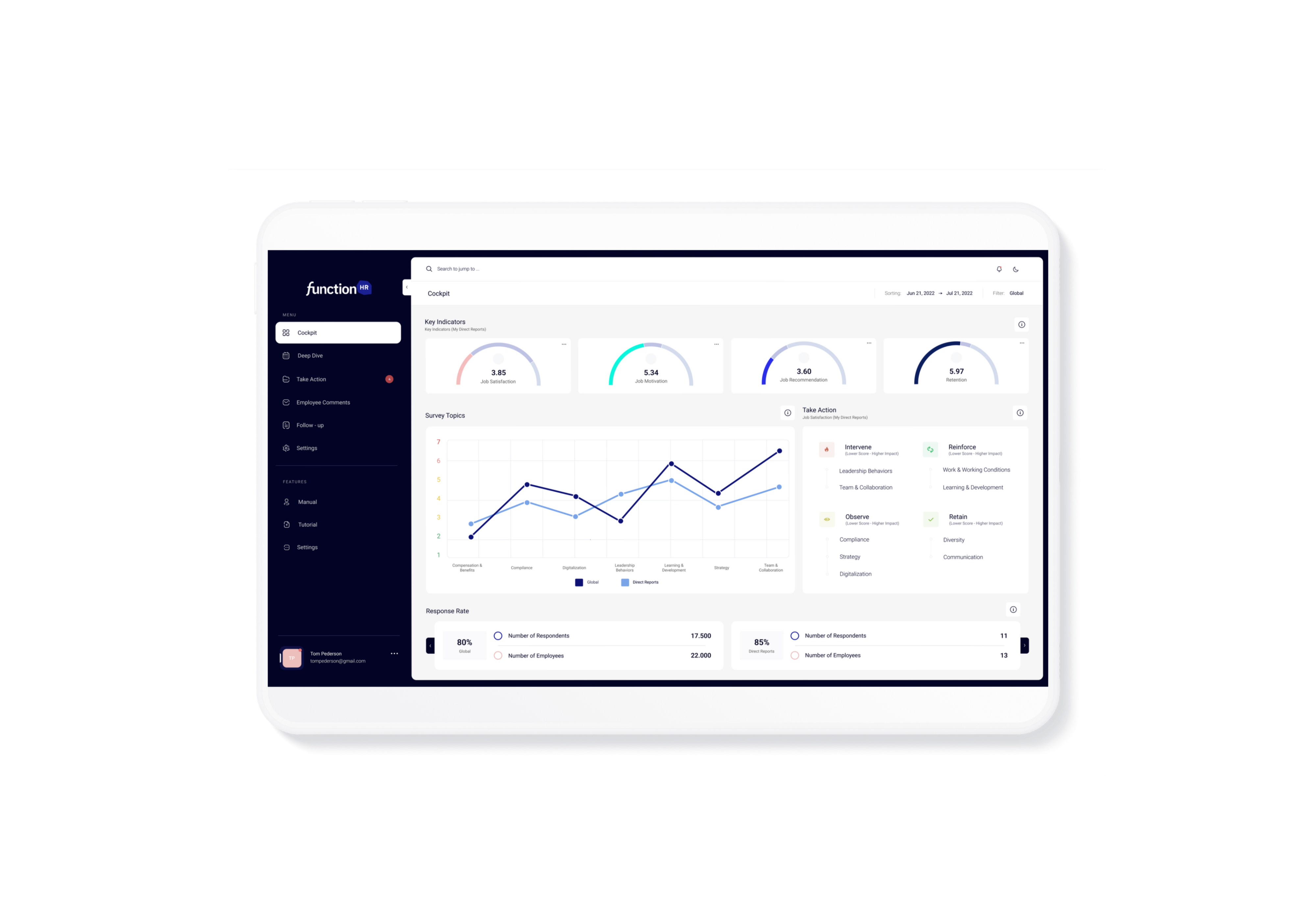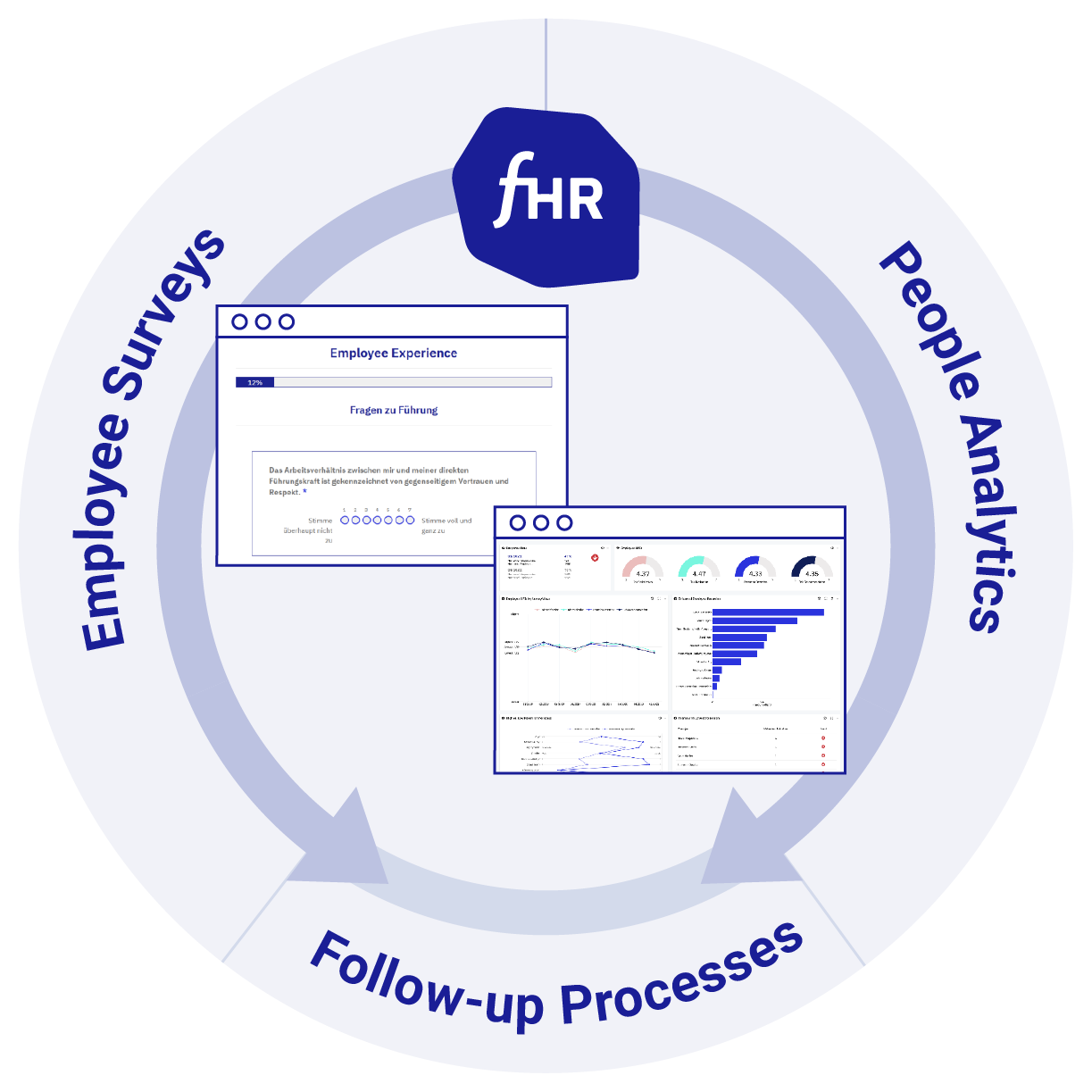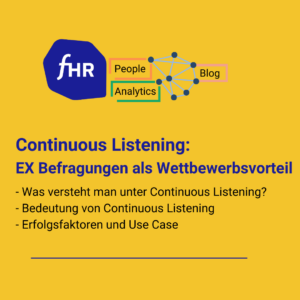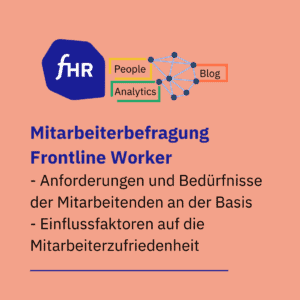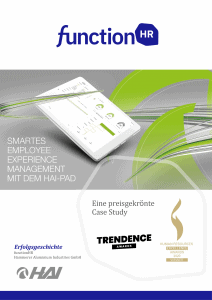
Employee Survey
Goal, evaluation, software, data protection

What are the benefits of a modern employee survey? What do I have to pay attention to when creating and conducting it? How do the evaluations lead to effective change processes?
Here we will answer these and many other questions about employee surveys. With many tips for executing the survey and analysing the survey data, important information on data protection – and much more.
Content
Hype about modern feedback instruments
What exactly is the ’employee voice’ all about? More and more companies are discovering the feedback of their employees as a basis for designing attractive workplaces and specific initiatives. After all, in the highly competitive labor market, talented people have a lot of options. Not only the younger generations are looking for an employer where they feel valued and can actively participate in shaping their everyday working lives.
Employee feedback is therefore not just a hype or trend in HR. It will be an integral part of the future workplace. This requires modern feedback tools which meet the relevant needs.
Feedback der Mitarbeiter:innen ist der Schlüssel zum Erfolg
In an employee survey, employees are systematically asked about their opinions and attitudes on various topics that are relevant to the company’s goals and strategy. With their participation in the survey, constructive feedback is collected and internal communication is promoted. Surveys are already a well established instrument for HR management. However, their use as a modern feedback tool requires modernization towards an agile survey concept.
Goals and benefits of an employee survey
Employee surveys are a means to an end and not an end in themselves: modern employee surveys pursue the goal of accompanying changes, bringing about improvements and evaluating actions taken.
Goals of an employee survey
Employees should not be surveyed simply for the sake of it. In fact, that could have severe negative consequences. Before a survey is set up and conducted, a clear goal must be defined.
Goals at a glance:
- Identification of weaknesses and opportunities for improvement
- Gathering information (satisfaction, working atmosphere, management style, feedback)
- Support of change processes
- Strengthening communication between managers and employees
- Control/assessment of work processes
- Benchmarking, i.e. collection of comparative data
The 4 benefits of an employee survey
Make better decisions: Establish a data-based foundation for your organizational development and decision-making to attract, develop and retain your employees.
Targeted use of employee feedback and HR data: Give your employees a voice and collect feedback on a variety of topics to improve the work experience in a focused way.
Introduce advanced data analytics: Benefit from AI-powered processes and diagnostic analytics to generate tailored recommendations for action.
Provide targeted support to managers: Enable data-based leadership to guide and evaluate change.
Conducting an employee survey in 8 steps
Conducting surveys is a multi-step project. That is why we recommend a continuous 8-step process for implementation, evaluation, and assessment.
Selection of modern employee survey software
Software plays a significant role in conducting online surveys. Digital employee surveys are a great facilitator for the efficient collection of feedback. The survey tool should consist of two components:
Modern surveys require an innovative software solution. It not only performs the survey but also covers the analytics process in a completely automated way. The results are made available in an interactive dashboard in real time. This greatly minimizes the effort required by HR staff and the free resources can be used entirely for the interpretation of the insights and the planning of strategically relevant actions.
When selecting a software, the general requirements must be determined in advance. Providers of employee surveys have different levels of maturity with regard to the features of their software solution and differ with regard to support for the entire survey process.
A professional provider covers all necessary features with a web-based software solution for conducting and evaluating employee surveys:
Selection of best-practice questionnaires from a broad catalog of survey items
Automated distribution of survey invitations and online questionnaire
Automated, AI-powered analysis of feedback in real time
Communication of results via role-specific dashboard views for all relevant user groups in a web-based, interactive dashboard
Derivation of specific recommendations for action
Evaluation of actions and change processes
Checkliste: Anbieterauswahl Mitarbeiterbefragungssoftware
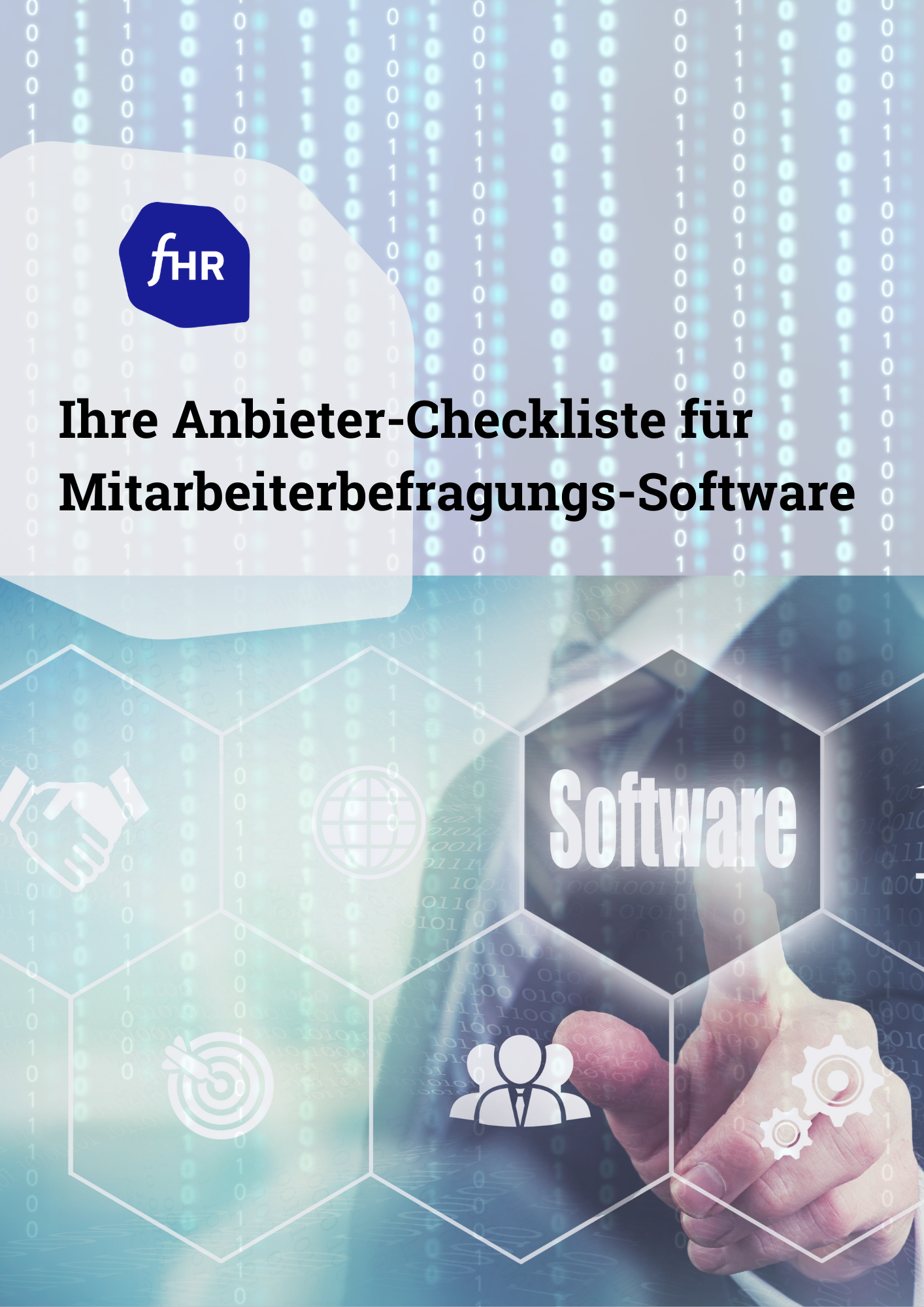
Fragebogenerstellung. Auswertung und Analyse. Maßnahmenplanung und Folgeprozess. Datenschutz. Eine Mitarbeiterbefragungssoftware muss einige Kriterien erfüllen. Diese Checkliste hilft Ihnen, Anbieter zu vergleichen und die für Sie passende Softwarelösung zu finden!
You are currently viewing a placeholder content from HubSpot. To access the actual content, click the button below. Please note that doing so will share data with third-party providers.
More InformationA variety of methods for employee surveys
Depending on the goal and context of the survey, different survey formats are used. The distinguishing criteria include:
- Purpose of the employee survey
- Form of data collection
- Selection of topics
- Design of the questionnaires
- Frequency and regularity





The company-wide employee survey is a systemic survey of the entire workforce. Typically, it is conducted every one to two years. A comprehensive questionnaire with various topics relevant to the company is designed for this purpose. The answers are the basis for statistical analysis, strategic management and far-reaching company decisions.
Typical topics:
- Employee satisfaction
- Employee commitment
- Organizational culture
- Business processes
- Leadership
- Change processes
This type of employee survey is the most common format. However, it also involves a very complex project. Experts advise conducting employee surveys on a more regular basis, in shorter intervals and with less questions.
Pulse surveys / pulse checks
Pulse checks are a modern form of employee surveys. They are characterized by a certain standardization, brevity and consistency. Employees answer a short survey on specific topics, e.g. teamwork or interim feedback on change processes. It is also possible to continuously monitor the success of implemented initiatives after a company-wide survey.
Regular pulse surveys ideally take place at intervals of three to six months. However, they should not be conducted more frequently in order to avoid survey fatigue among employees.
The 360-degree survey is also known as leadership feedback. In a holistic approach, feedback is provided by a variety of groups. These include employees, supervisors, colleagues and if applicable, even customers. In addition, managers make a self-assessment of their own leadership behavior. With this approach, strengths and weaknesses can be identified and targeted training programs can be initiated.
Surveys are increasingly being used to design and improve the employee experience. This involves taking a closer look at employees’ experiences at individual touchpoints along their employee journey.
- Candidate surveys
The candidate experience is becoming increasingly relevant in the competitive labor market. Candidate experience surveys are used to obtain feedback from candidates. In this way, the application process can be optimized and the recruitment success can be promoted.
- Onboarding surveys
Onboarding experience surveys support the successful integration of new employees. Tailored surveys are used to identify what is particularly important to new employees and what is still in need of improvement. This helps to make the employees’ first work experience a positive one and to minimize the risk of early turnover.
- Exit surveys
Exit surveys are a tool for HR managers to examine employee turnover and a data-based attempt to learn why they are leaving the company. As part of the offboarding process, exit surveys represent an important opportunity for companies. The insights gained from it are of great importance for the corporate culture as well as for people development and employee retention. An added benefit is that the survey in the offboarding process is not necessarily only focused on exit reasons but it also gives employees a chance to give honest feedback on any other revelant topic.
- Topic-specific surveys
Further surveys on a variety of topics are possible. Home office surveys improve the remote work experience. Collaboration surveys map internal communication flows and improve collaboration. Change surveys accompany transformation projects.
With an intelligent employee survey software, all these types of surveys can be conducted easily and efficiently. Employees appreciate that their opinion matters. In addition, the findings can be used to achieve positive changes at specific stages of the employee journey.
Questionnaire design
It is not as easy to set up a good questionnaire and to ask the right questions as it may seem. Before starting to draft the questions, the survey objective should be subdivided into several components. Individual questions are then tailored to these sub-areas. A standardized questionnaire with a mix of closed and open questions is then created. This creates a basis for the subsequent data evaluation and derivation of effective actions.
Standardized questionnaire
A standardized questionnaire is a basic requirement for a meaningful survey. Structured data collection increases the quality of the data collected. The analysis of standardized questionnaires is efficient and promotes comparability. Only in this way can meaningful insights and implications for action be gained. The development of a standardized questionnaire can be facilitated with templates and best practice recommendations.

Sie möchten wissen, wie ein idealer Fragebogen mit offenen und geschlossenen Fragen aussehen kann? Machen Sie es sich einfach: Unser Musterfragebogen ist nur einen Klick entfernt.
You are currently viewing a placeholder content from HubSpot. To access the actual content, click the button below. Please note that doing so will share data with third-party providers.
More InformationClosed and open questions
Questionnaires should include closed questions with scaled responses to the typical topic areas. Standardized questionnaires include questions on topics such as the job, leadership, corporate culture or communication. This allows the answers to be compared and evaluated objectively.
Open questions, i.e. free text fields, allow employees to communicate their opinions freely and honestly when answering the questions. Such qualitative questions make it possible to obtain feedback that cannot be classified on a scale with the click of a mouse. This results in concrete suggestions for improvement and insight into the issues that concern employees. Such information would not be possible via purely closed questions.
Evaluation of employee surveys
Extensive Excel spreadsheets and month-long evaluations: Company-wide employee surveys are a huge project not only in terms of implementation, but also in terms of evaluation. Manual analysis methods are time-consuming, error-prone and in most cases only mean values are calculated. Classic evaluations not only hurt companies financially, but also lead to devastating errors in interpretation. In other words, descriptive analytics alone are not sufficient for in-depth interpretation of results.
The potential of advanced and AI-supported analyses goes far beyond the ordinary evaluation methods of an employee survey. This is precisely where the potential resides for taking an analytical look at the voice of employees and identifying levers for improvement. In the process, the driving factors for motivation, job satisfaction and employee performance is revealed.
Surveys with built-in follow-up and change processes
Conducting employee surveys is only the first step towards improvement. The next step is to initiate and communicate follow-up processes supported by analytics. Stringent monitoring of the defined actions should be part of the holistic process.
Consistent monitoring of changes in the software
In order to establish a continuous improvement process, the use of a modern survey concept is recommended. Repeating employee surveys at regular intervals is important. Pulse surveys as interim checks are also useful. This way, any obstacles or problems in the change process can be identified and remedied in time. Interim goals and progress achieved are measured and transparently displayed in a dashboard to all relevant user groups.
Data protection - a key factor for success
Personal data and confidential feedback are collected and processed in employee surveys. To ensure a high participation rate, the trust of the survey participants must be secured. They must give their consent for the data to be analyzed. Information about the purposes of data processing must be provided. Data misuse and the tracing of responses to individual respondents must be prevented.
European regulations on data protection, data security and ethics
A number of laws define the data protection framework and limits for the data protection-compliant use of employee surveys.
- EU General Data Protection Regulation (EU-GDPR)
- German Federal Data Protection Act (BDSG)
- Ethical principles
It goes without saying that the company’s data protection officers should be involved in the planning process from the very beginning. As professional experts, they can advise on planning and implementation with regard to the legal situation and data protection compliance. This includes, for example, the following aspects for the data protection-compliant implementation and evaluation of employee surveys:
- Legally compliant declaration of consent by respondents for data processing
- Anonymity and pseudonymization of data
- Secure and encrypted data transmission
- Data processing in accordance with applicable laws and guidelines
- Transparency about analysis methods and algorithms used
- Access controls
Recommendation for data privacy compliance - employee survey software from external providers
Data privacy issues can be a sensitive matter. It is advisable to outsource the implementation, evaluation, hosting and reporting of the data to external service providers. These providers are experts in data protection, legally compliant analysis and evaluation, as well as in communicating the results. The anonymity of the participants is therefore better protected.
However, there are also a number of things to consider when selecting external solutions. Especially since the transatlantic “Privacy Shield” data protection agreement was declared invalid on July 16, 2020. It regulated the transfer of personal data between the US and the EU. In the European area, this has a significant impact on the use and selection of external providers and their appropriate level of data protection in accordance with the GDPR.

Der Europäische Gerichtshof (EuGH) hat das „Privacy Shield“ am 16. Juli 2020 für ungültig deklariert. In diesem Whitepaper klären wir über die Auswirkungen des Rechtsurteils auf den datenschutzkonformen Einsatz von Mitarbeiterbefragungen und People Analytics auf.
You are currently viewing a placeholder content from HubSpot. To access the actual content, click the button below. Please note that doing so will share data with third-party providers.
More InformationCosts of an employee survey
Whether an employee survey is expensive depends primarily on the way it is implemented and the follow-up processes. Surveys without a clear goal and follow-up process not only lead to dissatisfied employees, but also to financial losses. In this case, resources are actually wasted.
The situation is quite different, however, when the real problem areas are identified and addressed. These include typical problems such as absenteeism, employee turnover, retention, satisfaction or motivation. If you use analytics to systematically evaluate employee feedback and gain a target-group-specific insight – for example, depending on locations, job groups, departments – into employee experiences, you know what needs to be done. If, for example, the analysis can prevent the turnover (and associated turnover costs) of just a few employees, the business case pays off quite quickly. The manufacturing company HAI, for example, has achieved savings in turnover costs in the 6-digit range in just one year with the help of employee surveys.
Industry Insights: How data-driven people management adds measurable value to business success
Goals | Employee Surveys |
|---|---|
|
|
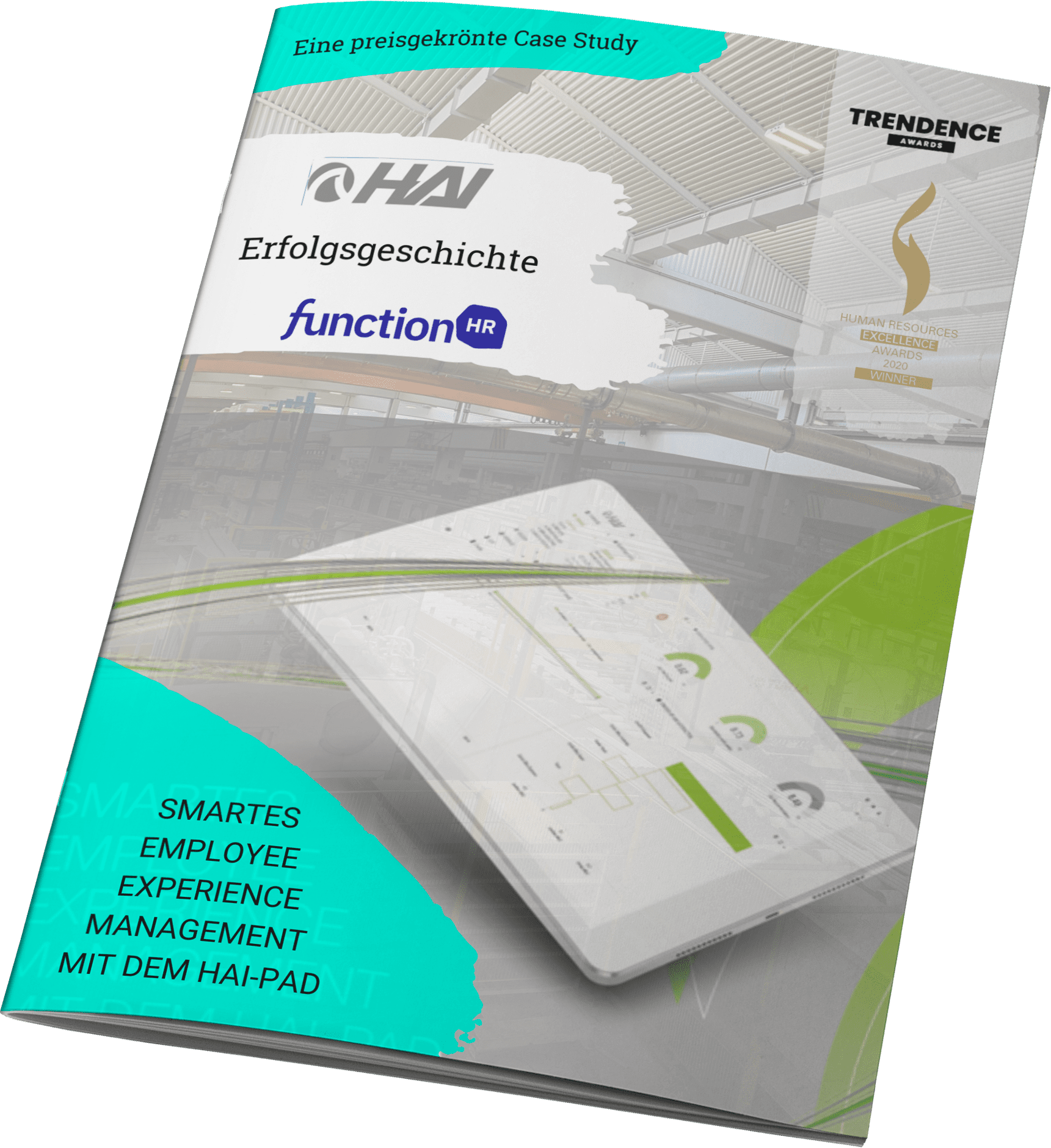
HAI Success Story
Hammerer Aluminium Industries was able to reduce early turnover by 45% and overall turnover by 25% within one year through the use of employee surveys, saving over €1 million in turnover costs and improving their Net Promoter Score by 14 points.
DO's: Beachten Sie folgende Tipps
- Setzen Sie sich ein konkretes Ziel: Was soll mit der Befragung erreicht werden? Nur mit einem konkreten Ziel kann eine systematische Datenerhebung und -auswertung erfolgen.
- Legen Sie Wert auf transparente Kommunikation: Transparenz schafft Akzeptanz. Der frühzeitige Dialog mit verschiedenen Stakeholdern erhöht die unternehmensweite Unterstützung und somit auch die Teilnahmequote an der Befragung. Zeitnah nach der Umfrage sollten die Ergebnisse, d.h. sowohl die identifizierten Problemfelder als auch die konkreten Veränderungsmaßnahmen, an alle kommuniziert werden.
- Binden Sie den Betriebsrat mit ein: Eine frühzeitige und konstruktive Zusammenarbeit mit dem Betriebsrat fördert den Erfolg der Befragung und räumt Vorbehalte aus.
- Beachten Sie den Datenschutz: Leitlinien der DSGVO und ethische Richtlinien bestimmen die datenschutzkonforme Durchführung und Auswertung der Befragung.
- Ziehen Sie Experten für Data Analytics hinzu: Experten in Data Analytics und mit umfangreichem HR-Verständnis sollten eine Schnittstellenfunktion einnehmen und die korrekte Datenverarbeitung und -analyse begleiten. So kann der mittel- und langfristige Erfolg der Befragung sichergestellt werden.
DON'Ts: Vermeiden Sie diese Fehler
- Mitarbeiterbefragungen ohne richtigen Folgeprozess: Befragungen sind ein Zwischenschritt auf dem Weg zu Veränderungen und Verbesserungen. Verschwinden die Ergebnisse in der Schublade, ohne daraus Maßnahmen abzuleiten und eine Folgeprozess aufzusetzen, führt das zu frustrierten und demotivierten Mitarbeiter:innen.
- Unzulässige Analysen und Verwendung von KI: Die inkorrekte Ausführung der Analysen und fehlendes Know-How über KI-gestützte Analysemethoden können verheerende Folgen nach sich ziehen.
- Die Befragung erfolgt nicht anonym und freiwillig: Nicht nur der Datenschutz erfordert Anonymität für die Befragten. Auch der Anspruch an ehrliches Feedback und aussagekräftige Ergebnisse wäre nicht erfüllt, wenn diese Anforderung nicht gegeben wäre.
- Der Fragebogen ist kompliziert und fehlerhaft: Suggestivfragen, komplizierte Sprache sowie doppelte Verneinungen und einige weitere Hürden müssen in der Erstellung des Fragebogens vermieden und der logische Aufbau der Fragen beachtet werden. Andernfalls leiden die Teilnahme und Auswertung der Daten darunter.
Would you also like to use our employee survey software for your company? Book a free demo now!
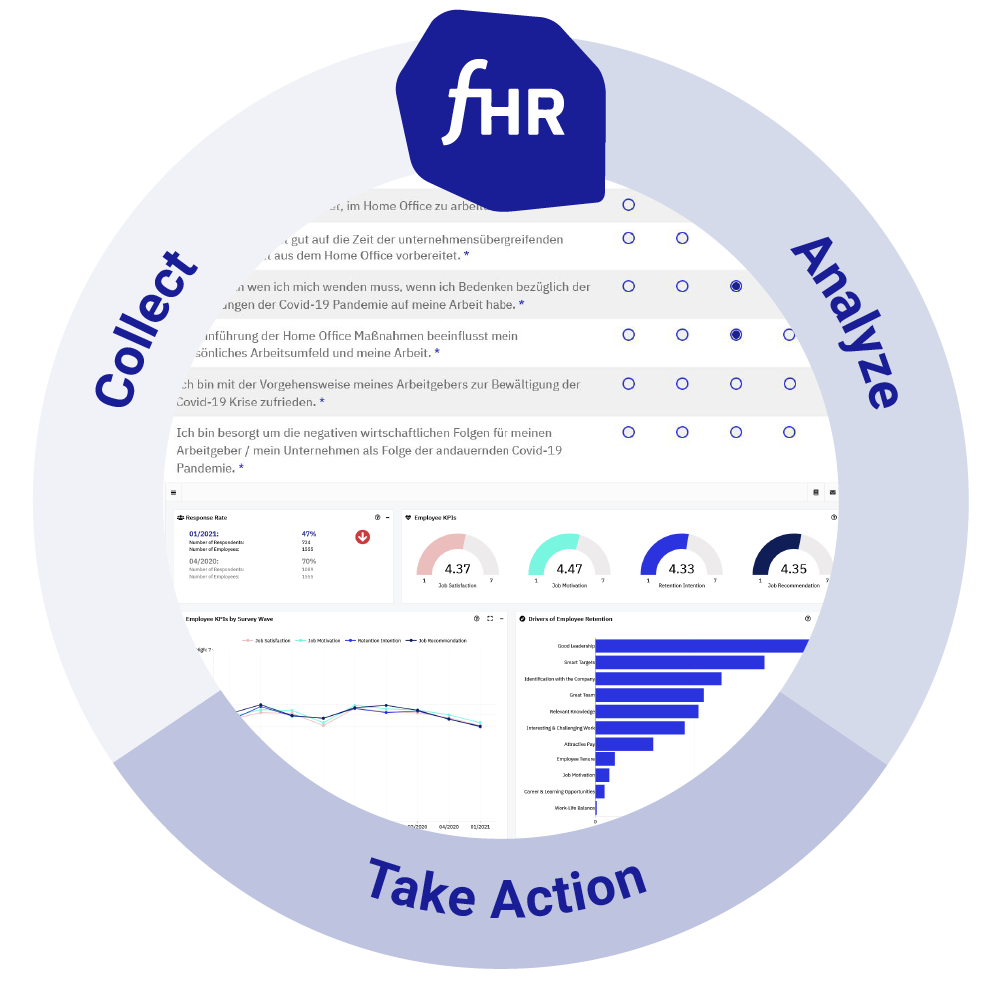
Give your employees a voice and use valuable feedback for successful change processes.
Passende Beiträge in unserem Blog:
Kostenfreie Downloads für Sie:
Free checklist
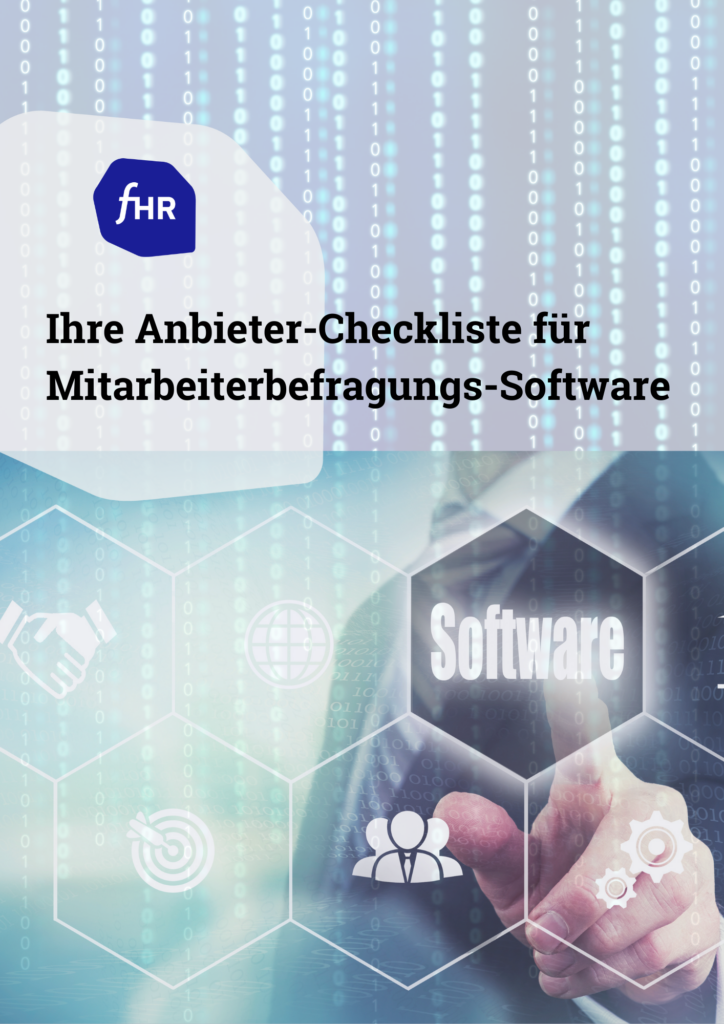
You are currently viewing a placeholder content from HubSpot. To access the actual content, click the button below. Please note that doing so will share data with third-party providers.
More InformationUse this checklist to support you in critically examining various survey providers on the market!


